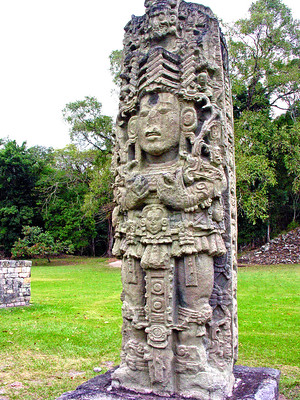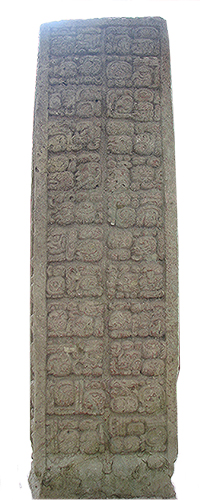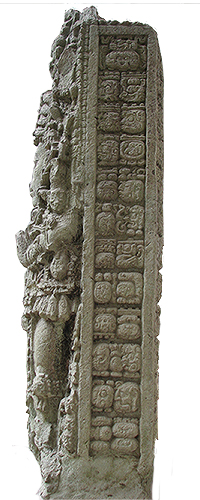Stela A
Location: North of Structure 4, Main Plaza
Dates: 9.14.19.8.0 12 Ajaw 8 Kumk’u / 731 CE
Rulers: 13, 11
Measurements: 11.65 feet x 2.85 feet x 2.56 feet, relief 1.7 feet deep, frame 5.87 feet x 5.64 feet x 1.28 feet (Baudez 1994, 19)

Dennis J. Honduras-0265 - Waxaklajuun Ub’aah K’awiil, 2007, photograph. Flickr.
Erected by Waxaklajuun Ubaah K’awiil, Stela A faces eastward across the Main Plaza directly across from Stela H, erected by the thirteenth ruler three winals beforehand (Fash 2011, 58). The stela, overlooking its altar on the central axis of Structure 4, is believed to have been erected in dedication of this structure, with the ruler’s stone eyes watching the ceremony. The stela stands on a cruciform chamber filled with pottery and is surrounded by a circular platform (Baudez 1994, 19).
Stela A is a Type IV stela with three sides of text and one figural side (Fash 2004, 259). The monument was carved at over eleven and a half feet tall in Waxaklajuun Ubaah K’awiil’s signature high relief style (Baudez 1994, 19). Notably, this stela is one of the few today with a surviving face (Fash 2011, 58).
On the eastern side of the stela, Waxaklajuun Ubaah K’awiil stands facing front in a tall cylindrical headress comprised of three braids woven into a mat adorned with ribbons (Baudez 1994, 19). Feathers may be attached to the headdress, and a serpent head surrounds the braids. A skeletal serpent appears on either side of the headdress with a k’in sign on its forehead, filed incisors, and wrinkles. The king wears large simple earflares, and his hair falls behind his ears. A skull with vegetation sits above the king, surrounded by snakes. His wristlets and anklets depict lancets in the form of serpent heads with three braids. Bird masks adorn his knees. Staffs surround his legs which end in serpent heads. From the head on the left emerges a being with a k’in sign on its forehead. From the head on the right emerges a being evoking the skull with vegetation motif (Baudez 1994, 23). In his hands he carries the double headed centipede bar (Martin and Grube 2008, 204).
This stela evokes rulership motifs through its use of the mat headdress, serpent bars emerging from braided serpents surrounding the king, and potentially the skull with vegetation motif appearing twice in this stela. In certain circumstances, the skull with vegetation motif has been used to celebrate accessions (Baudez 1994, 23). The imagery also emphasizes the association between the sun and sacrifice and the ensuing death and rebirth bearing fertility. The skeletal serpents bear solar imagery, and an emerging elongated skull next to the king also forms a part of the witz glyph (Baudez 1994, 22). The lancets and ribbons also evoke the bloodletting rituals needed for the sun to rise. The subsequent fertility imagery emerges from the skull and vegetation motifs, both over the king and in the skeletal serpent bearing waterlily imagery. This combination of skeletal serpent and waterlilies would also feature heavily in Structure 18 (Baudez 1994, 23).



Stela A Text
Photos Courtesy of Dr. Clark Erickson
Interestingly, this stela, like Stela H, honors Butz’ Chan the eleventh ruler by describing rituals in which bones or relics would be sliced from the dead king’s tomb (Fash 2011, 58). This susaj baak ritual had been completed the year prior, and its mention on this stela speaks to the regard for the eleventh ruler (Martin and Grube 2008, 200). One of the verbs used in this description had previously only been found in Palenque’s Tablet 14. The term celebrated their king Chan-Bahlum’s departure from Xibalba three haabs and one tzolk’in after death and was also used to celebrate ancestors and their spiritual rebirth (Schele and Stuart 1986, 51).
The text of Stela A also mentions the Lowland capitals Tikal, Palenque, and Calakmul, assigning each of them a cardinal direction along with Copan (Fash 2011, 59). While the association of Copan with the capitals may seem ambitious, Tikal king Jasaw Chan K’awiil I did inscribe information concerning Copan and Palenque on bones circa 730 (Martin and Grube 2008, 47). Whether or not Waxaklajuun Ubaah K’awiil was noting their arrival in Copan, the thirteenth ruler certainly used their appearance to his advantage. Stela A has an impressively rhetorical aim in celebrating a previous king, evoking sacrifice, rulership, and the resulting fertility, and invoking the three most powerful Maya Lowland cities on a monument erected only sixty days after his previous stela. True to form, Waxaklajuun Ubaah K’awiil delivers in grandeur and abundance.
Motifs
- Centipede
- Lancet wristband
- Mat
- Serpent Bar
- Skeletal snake
- Skull and vegetation
- Solar Deities
- Waterlily
- Witz
See Also:
Sources:
- Baudez, Claude-François. 1994. Maya Sculpture of Copán: The Iconography. Norman: University of Oklahoma Press.
- Fash, Barbara W. 2011. Copan Sculpture Museum, The . Cambridge: Peabody Museum Press.
- Fash, Barbara W. 2004. “Early Classic Sculptural Development at Copan.” In Understanding Early Copan, edited by Ellen E. Bell, Marcello A. Canuto, & Robert J. Sharer, 249-264. Philadelphia: University of Pennsylvania Museum of Archaeology and Anthropology
- Martin, Simon and Nikolai Grube. 2008. Chronicle of the Maya Kings and Queens: Dynasties of the Ancient Maya. London: Thames and Hudson
- Schele, Linda and David Stuart. 1986. “Copan Note 14: Butz-Chan, the 11th Successor of the Yax-K’uk-Mo’ Lineage” In Copan Notes, The 47-56. Austin, TX: Copan Mosaic Project.
Photograph
- Honduras-0265 - Waxaklajuun Ub'aah K'awiil, by Dennis Jarvis, is licensed by CC-by-SA 2.0.
- All other photographs (Edited) Courtesy of Dr. Clark Erickson